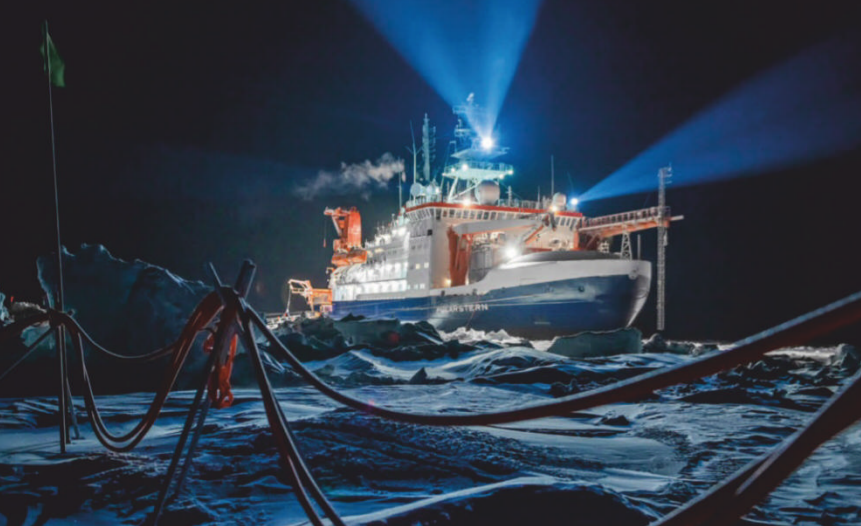There is "lockdown". And then there is lockdown.
船只“封锁”。国家封锁。
Those who have spent the past weeks allowed out only to exercise and visit the shops
那些在过去几周只被允许出去锻炼和逛商店的人
might spare a thought for the passengers and crew of Polarstern (Pole Star), pictured above.
可能会想到上图中极星号上的乘客和船员。
Polarstern is an icebreaker belonging to the Alfred Wegener Institute for Polar and Marine Research, in Germany,
极星号是一艘破冰船,所属德国阿尔弗雷德韦格纳极地和海洋研究所,
and her ship's company are in a different class of lockdown entirely. Their vessel is afloat in the pack ice of the Arctic Ocean,
而船上的同伴则完全处于另一种级别的禁闭中。他们的船漂浮在北冰洋的浮冰中,
and communications are so minimal as to preclude phone calls, let alone Zoom. Only pictureless messages and emails are possible.
通讯设备极少,无法打电话,更别提使用Zoom视频了。能用的只有不带图片的短信和邮件。
Polarstern is the location of MOSAIC, the Multidisciplinary drifting Observatory for the Study of Arctic Climate.
极星号是北极气候研究多学科漂移观测站(MOSAIC)所在地。
She sailed from Tromso, in Norway, on September 20th 2019 and travelled to a point at latitude 85 degrees North.
2019年9月20日,她从挪威特罗姆瑟触发,航行到北纬85度的一个点。
Here, mimicking the first high-Arctic voyage, made in 1893 by Fridtjof Nansen, a Norwegian explorer,
模仿挪威探险家弗里德乔夫·南森在1893年进行的第一次高北极航行,
her captain fixed her into an ice floe that carried her along at about 7km/h, courtesy of an ocean current called the transpolar drift stream.
船长把她固定在一块浮冰上,借助一股被称为“跨极漂流”的洋流,让她以每小时7公里的速度向前移动。
Her closest approach to the pole itself, 156km, was on February 24th.
2月24日是她离极点最近的时间,距离为156米。

Things have not, however, gone according to plan. The idea was for a revolving cast of 300 scientists each to spend two months on board.
然而,事情并没有按照计划进行。原计划是让300名科学家轮班各在船上待两个月。
This would have permitted specialists in the study of different seasons and conditions—winter or summer ice, say—to be there at the appropriate moment,
这样就可以让研究不同季节和环境的专家在合适的时间到达那里,比如冬或夏冰,
and would also have had the benefit of protecting everyone from cabin fever.
而且还能保护每个人远离幽居病。
A planned rotation in April had, though, to be cancelled.
不过,计划在4月进行的轮换已被取消。
Norway, the new shipmates' intended departure point, had closed its borders in response to covid-19.
为应对covid-19疫情,新船员的预定出发地——挪威已经关闭了边境。
That left the original company with no liberation date. Eventually, two transfer ships with the newbies on board sailed from Bremerhaven, in Germany.
这使得原来的同伴没有了解放之日。最终,两艘载着这些新船员的转运船从德国不莱梅港启航。
And on May 17th Polarstern broke free from her icy prison and headed south to meet them off the coast of Svalbard.
5月17日,极星号从冰封的监狱中挣脱出来,向南前往斯瓦尔巴特群岛海岸与他们会合
On June 8th she began the return trip, and arrived back at her original piece of ice (which had moved) on June 17th,
6月8日,她开始返航之旅,6月17日,她回到了原来那块冰的位置(这块冰已经移动了),
to resume drifting with it until she breaks free in September, in the Fram Strait between Greenland and Svalbard.
继续随它漂流,直到9月,在格陵兰岛和斯瓦尔巴特群岛之间的弗拉姆海峡获得解放。
The coronavirus has not changed MOSAIC's objectives, however.
但疫情没有改变MOSAIC的目标。
These are to study the structure of Arctic ice and how this changes with the seasons,
MOSAIC的目标是研究北极冰的结构以及其结构如何随着季节而变化,
and to look at the air above that ice, the water below and the creatures living in that water—and, indeed, in the ice itself. All of these are interlinked.
并观察冰层上的空气、冰下的水以及水中生活着的生物——事实上,还有生活在冰里的生物。所有这些都是相互联系的。
They also link the place with the wider world, for the Arctic is both a recorder and a driver of climate change.
他们还将北极与更广阔的世界联系起来,因为北极既是气候变化的记录者,也是气候变化的推动者。
It is a recorder because the visible difference between ice and water,
它是记录者,因为冰和水的明显区别
and the obvious relationship between global temperatures and the amount of ice around,
以及全球气温和周围冰量之间的明显关系,
mean together that the ice's waxing and waning shows in an easily graspable way how things are changing.
两者都意味着冰的消长变化简易地表明了事物是如何变化的。
译文由可可原创,仅供学习交流使用,未经许可请勿转载。



